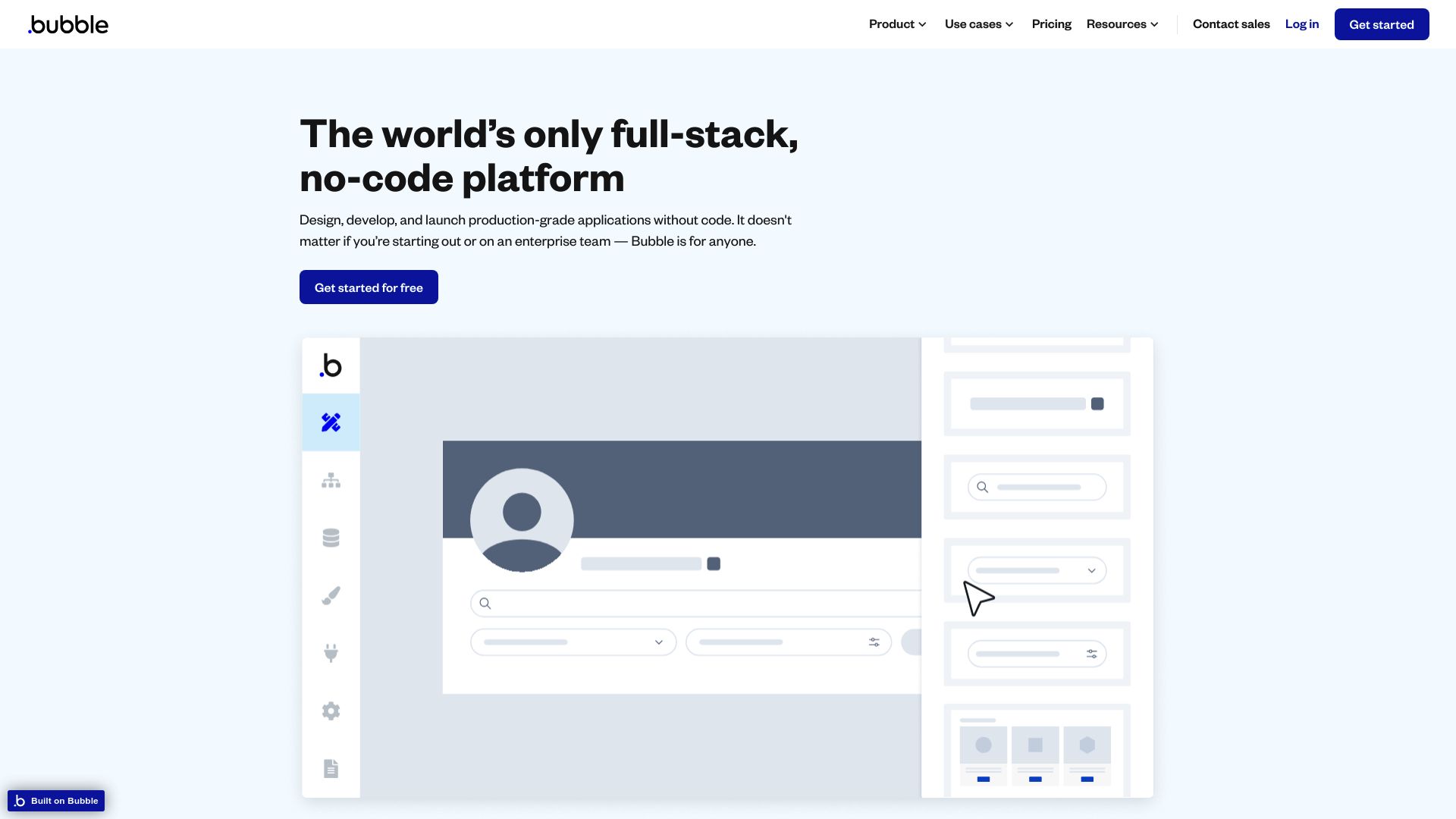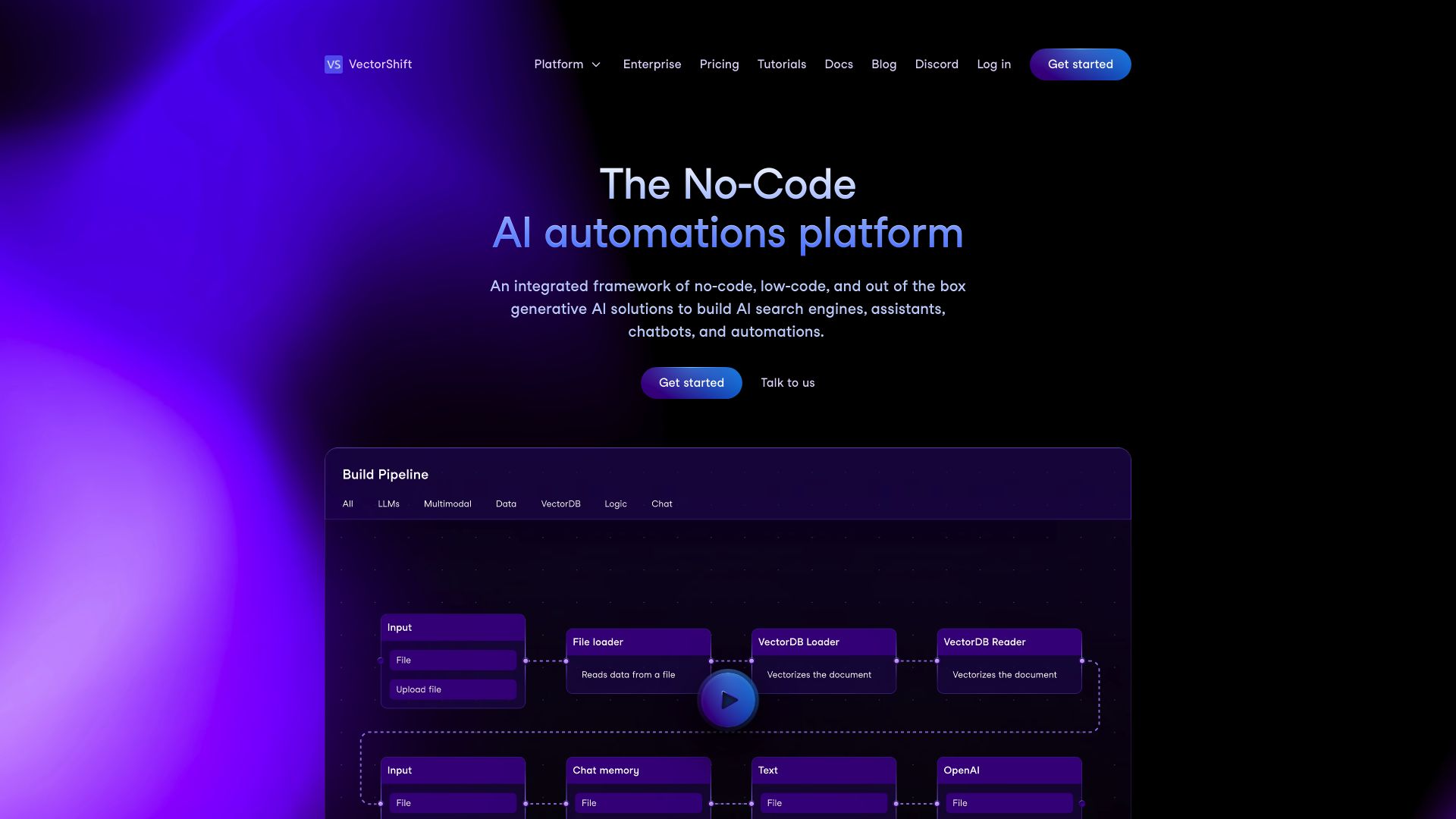Bubble vs. VectorShift: Comparing AI-Powered App Development Platforms
AI-powered application development platforms are revolutionizing how businesses create and deploy software solutions. This comparison explores Bubble vs. VectorShift, and SmythOS, three distinct platforms catering to different aspects of the AI and no-code development landscape. Bubble shines in visual web app creation, enabling users to build complex applications without coding.
VectorShift specializes in AI workflow design and automation, offering both no-code and code SDK interfaces. SmythOS emerges as a comprehensive solution, combining visual development with advanced AI capabilities and enterprise-grade features. This review delves into each platform’s strengths, limitations, and unique offerings, providing developers, business leaders, and AI enthusiasts with insights to choose the right tool for their AI-driven projects.
Bubble Overview
Bubble empowers users to build web applications without coding. The visual development platform caters to entrepreneurs, small businesses, and enterprise teams seeking to rapidly create and deploy custom software solutions.


Bubble’s drag-and-drop interface simplifies the app-building process, allowing users to design, develop, and launch fully functional web applications. The platform supports database management, user authentication, and dynamic content creation. Bubble integrates with popular services and APIs, enabling developers to incorporate advanced features like payment processing and AI capabilities.
Bubble’s drag-and-drop interface simplifies the app-building process, allowing users to design, develop, and launch fully functional web applications.
While Bubble excels in visual development, it faces limitations in certain areas. The platform lacks native support for mobile app development, requiring third-party tools for iOS and Android deployment. Complex applications may encounter performance issues, and the learning curve can be steep for users seeking advanced customization.
Despite these challenges, Bubble’s robust ecosystem and active community provide extensive resources for users. The platform’s marketplace offers plugins and templates to extend functionality and accelerate development. Bubble’s commitment to scalability ensures applications can grow alongside user bases, making it a viable option for startups and established businesses alike.
VectorShift Overview
VectorShift empowers users to design, prototype, build, and manage generative AI workflows and automations. The platform offers dual interfaces—a no-code builder and a code SDK—catering to both technical and non-technical users alike.
VectorShift’s pipeline dashboard stands out as its core feature, allowing users to create AI workflows from scratch or with templates. This streamlines the deployment process, making it efficient for various applications such as chatbots, search functionalities, and content creation. The platform’s integration capabilities with data sources like Google Drive, Slack, and Airtable enable centralized data management and live-syncing across applications.
VectorShift’s pipeline dashboard stands out as its core feature, allowing users to create AI workflows from scratch or with templates.


VectorShift’s comprehensive automation capabilities allow users to create end-to-end workflows, schedule tasks, and trigger actions based on predefined events. The platform’s knowledge base centralizes data and performs semantic searches, enhancing the AI’s ability to provide accurate and relevant information. Users can deploy their pipelines as chatbots, automations, or search functions, with various customization and export options.
While VectorShift offers a robust set of features, it lacks some advanced capabilities found in other platforms. For instance, it doesn’t provide hosted vector databases or specialized crawlers for sitemaps, YouTube transcripts, or URLs. Additionally, the platform doesn’t offer autonomous agents or multi-agent collaboration features, which may limit its applicability in certain complex AI scenarios.
VectorShift aims to democratize AI workflow creation and management, making it accessible to a wide range of users. Its vision focuses on empowering individuals and businesses to leverage AI for task automation, content creation, and data management, ultimately boosting efficiency and productivity across various industries.
Feature Comparison
Bubble and VectorShift highlight key differences in their approaches to AI-powered application development. Bubble excels in visual web app creation without coding, while VectorShift specializes in generative AI workflows and automations.
Bubble’s strength lies in its comprehensive no-code platform for building web applications. It offers a visual interface and extensive integrations, allowing users to create complex apps without programming expertise. However, Bubble lacks native AI agent capabilities and autonomous AI features. It relies on third-party integrations to incorporate AI functionalities, limiting its potential for advanced AI-driven solutions.
VectorShift, in contrast, focuses on AI-centric workflows and automations. It provides both no-code and code SDK interfaces, catering to technical and non-technical users alike. VectorShift’s pipeline dashboard enables the creation of AI workflows, supporting applications like chatbots, search functions, and content generation. Unlike Bubble, VectorShift offers more robust AI-specific features, including a knowledge base for semantic searches and deployment options for AI-powered chatbots and automations.
In terms of core components, Bubble falls short in providing dedicated AI agent hosting, memory and context management for AI interactions, and multi-agent collaboration. VectorShift addresses these gaps with its emphasis on AI workflow design and deployment. However, VectorShift also lacks some advanced features like hosted vector databases or specialized crawlers, which limits its data processing capabilities compared to more comprehensive AI platforms.
Security-wise, both platforms offer data encryption and authentication methods. However, neither provides advanced features like IP control or constrained alignment for AI behavior, which are crucial for enterprise-level AI deployments requiring stringent security measures.
While both Bubble and VectorShift offer valuable tools for application development, they serve different niches within the AI and no-code landscape. Bubble provides a more general-purpose platform for web application development with limited AI capabilities, while VectorShift offers a specialized environment for AI-driven workflow creation and automation.
Feature Comparison Table
| Bubble | VectorShift | SmythOS | |
|---|---|---|---|
| CORE FEATURES | |||
| Hosted Agents (Dev, Production) | ✅ | ❌ | ✅ |
| Environments (Dev, Production) | ✅ | ❌ | ✅ |
| Memory & Context | ❌ | ✅ | ✅ |
| Autonomous Agents | ❌ | ❌ | ✅ |
| Explainability & Transparency | ❌ | ❌ | ✅ |
| Debug Tools | ✅ | ❌ | ✅ |
| Multimodal | ❌ | ✅ | ✅ |
| Multi-Agent Collaboration | ❌ | ❌ | ✅ |
| Audit Logs for Analytics | ✅ | ❌ | ✅ |
| Bulk Work | ❌ | ✅ | ✅ |
| Agent Work Scheduler | ❌ | ✅ | ✅ |
| SECURITY | |||
| Constrained Alignment | ❌ | ❌ | ✅ |
| Data Encryption | ✅ | ❌ | ✅ |
| IP Control | ❌ | ❌ | ✅ |
| COMPONENTS | |||
| Huggingface AIs | ❌ | ❌ | ✅ |
| Zapier APIs | ✅ | ❌ | ✅ |
| Classifiers | ❌ | ❌ | ✅ |
| Data Lakes | ✅ | ❌ | ✅ |
| DEPLOYMENT OPTIONS (EMBODIMENTS) | |||
| Deploy as API | ❌ | ✅ | ✅ |
| Staging Domains | ✅ | ❌ | ✅ |
| Production Domains | ✅ | ❌ | ✅ |
| Deploy as Scheduled Agent | ❌ | ✅ | ✅ |
| Deploy as GPT | ✅ | ❌ | ✅ |
| DATA LAKE SUPPORT | |||
| Hosted Vector Database | ❌ | ✅ | ✅ |
| Sitemap Crawler | ❌ | ❌ | ✅ |
| YouTube Transcript Crawler | ❌ | ✅ | ✅ |
| URL Crawler | ❌ | ✅ | ✅ |
Best Alternative to Bubble and VectorShift
SmythOS stands out as the superior alternative to Bubble and VectorShift for AI agent development and deployment. Our platform combines the best of both worlds, offering a user-friendly interface with powerful AI capabilities that surpass the limitations of our competitors.
We designed SmythOS to streamline the creation of sophisticated AI agents without sacrificing functionality. Unlike Bubble’s focus on general web app development or VectorShift’s emphasis on AI workflows, SmythOS provides a comprehensive ecosystem for building, deploying, and managing AI agents across multiple use cases.
SmythOS provides a comprehensive ecosystem for building, deploying, and managing AI agents across multiple use cases.
Our drag-and-drop interface rivals Bubble’s ease of use while offering advanced AI features that VectorShift lacks. SmythOS empowers users to create autonomous agents with robust memory and context management, multimodal capabilities, and seamless multi-agent collaboration. These features enable the development of AI solutions that can handle complex tasks and adapt to various scenarios.
Unlike our competitors, SmythOS offers unparalleled flexibility in deployment options. We support a wide range of embodiments, including APIs, webhooks, chatbots, scheduled agents, and integration with popular platforms like GPT. This versatility ensures that our users can implement AI solutions across diverse environments and use cases, from customer service to data analysis and beyond.
SmythOS also prioritizes security and scalability, addressing crucial enterprise needs that Bubble and VectorShift overlook. Our platform includes advanced features like constrained alignment, data encryption, and IP control, ensuring that AI agents operate within defined parameters and comply with stringent security requirements. Combined with our scalable infrastructure, SmythOS provides a robust foundation for building and deploying AI agents at any scale, from small businesses to large enterprises.
Conclusion
Bubble, VectorShift, and SmythOS offer distinct approaches to application development and AI integration. Bubble excels in visual web app creation without coding, while VectorShift specializes in AI workflow design. However, SmythOS emerges as the superior choice, combining the strengths of both platforms and addressing their limitations.
SmythOS’s drag-and-drop interface rivals Bubble’s ease of use, while its AI-centric features surpass VectorShift’s capabilities. Unlike Bubble, SmythOS provides native AI agent hosting, memory management, and multi-agent collaboration. It also offers more advanced features than VectorShift, including hosted vector databases and specialized crawlers.
Security-wise, SmythOS outperforms both alternatives with features like IP control and constrained alignment for AI behavior. These enterprise-grade security measures make it ideal for businesses requiring stringent data protection.
SmythOS truly shines in its versatility and comprehensive feature set. From visual builders to code SDK interfaces, from chatbots to APIs, SmythOS caters to both technical and non-technical users. Its extensive integration ecosystem, supporting over 300,000 integrations, eclipses the offerings of both Bubble and VectorShift.
Create free SmythOS account today to experience the future of AI-powered application development. With SmythOS, you’ll have access to cutting-edge AI capabilities, unmatched deployment flexibility, and a platform that grows with your needs. Don’t just build applications—create intelligent, scalable solutions that drive your business forward.
Last updated:
Disclaimer: The information presented in this article is for general informational purposes only and is provided as is. While we strive to keep the content up-to-date and accurate, we make no representations or warranties of any kind, express or implied, about the completeness, accuracy, reliability, suitability, or availability of the information contained in this article.
Any reliance you place on such information is strictly at your own risk. We reserve the right to make additions, deletions, or modifications to the contents of this article at any time without prior notice.
In no event will we be liable for any loss or damage including without limitation, indirect or consequential loss or damage, or any loss or damage whatsoever arising from loss of data, profits, or any other loss not specified herein arising out of, or in connection with, the use of this article.
Despite our best efforts, this article may contain oversights, errors, or omissions. If you notice any inaccuracies or have concerns about the content, please report them through our content feedback form. Your input helps us maintain the quality and reliability of our information.
